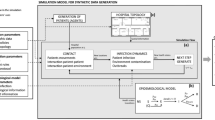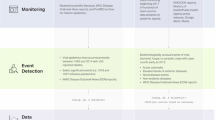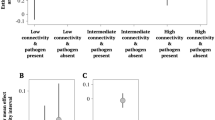Abstract
Hospitalized patients are at risk for increased length of stay, illness, or death due to hospital acquired infections. The majority of hospital transmission models describe dynamics on the level of the host rather than on the level of the pathogens themselves. Accordingly, epidemiologists often cannot complete transmission chains without direct evidence of either host–host contact or a large reservoir population. Here, we propose an ecology-based model to explain the transmission of pathogens in hospitals. The model is based upon metapopulation biology, which describes a group of interacting localized populations and island biogeography, which provides a basis for how pathogens may be moving between locales. Computational simulation trials are used to assess the applicability of the model. Results indicate that pathogens survive for extended periods without the need for large reservoirs by living in localized ephemeral populations while continuously transmitting pathogens to new seed populations. Computational simulations show small populations spending significant portions of time at sizes too small to be detected by most surveillance protocols and that the number and type of these ephemeral populations enable the overall pathogen population to be sustained. By modeling hospital pathogens as a metapopulation, many observations characteristic of hospital acquired infection outbreaks for which there has previously been no sufficient biological explanation, including how and why empirically successful interventions work, can now be accounted for using population dynamic hypotheses. Epidemiological links between temporally isolated outbreaks are explained via pathogen population dynamics and potential outbreak intervention targets are identified.
Similar content being viewed by others
Log in or create a free account to read this content
Gain free access to this article, as well as selected content from this journal and more on nature.com
or
References
The Review on Antimicrobial Resistance. Tackling drug-resistant infections globally: final report and recommendations. London: United Kingdom; 2016.
Palmore TN, Henderson DK. Managing transmission of carbapenem-resistant enterobacteriaceae in healthcare settings: a view from the trenches. Clin Infect Dis. 2013;57:1593–9.
Hayden MK, Lin MY, Lolans K, Weiner S, Blom D, Moore NM, et al. Prevention of colonization and infection by klebsiella pneumoniae carbapenemase-producing enterobacteriaceae in long-term acute-care hospitals. Clin Infect Dis. 2015;60:1154–61.
Wang X, Panchanathan S, Chowell G. A data-driven mathematical model of CA-MRSA transmission among age groups: evaluating the effect of control interventions. PLoS Comput Biol. 2013;9:e1003328.
Boyce JM. Environmental contamination makes an important contribution to hospital infection. J Hosp Infect. 2007;65:50–4.
Pittet D, Hugonnet S, Harbarth S, Mourouga P, Sauvan V, Touveneau S, et al. Effectiveness of a hospital-wide programme to improve compliance with hand hygiene. Lancet. 2000;356:1307–12.
Snitkin ES, Zelazny AM, Thomas PJ, Stock F, Henderson DK, Palmore TN, et al. Tracking a hospital outbreak of carbapenem-resistant Klebsiella pneumoniae with whole-genome sequencing. Sci Transl Med. 2012;4:148ra116.
Haller S, Eller C, Hermes J, Kaase M, Steglich M, Radonic A, et al. What caused the outbreak of ESBL-producing Klepbsiella pneumoniae in a neonatal intensive care unit, Germany 2009 to 2012? Reconstructing transmission with epidemiological analysis and whole-genome sequencing. BMJ Open. 2015;5:e007328.
Köser CU, Holden MT, Ellington MJ, Cartwright EJ, Brown NM, Ogilvy-Stuart AL, et al. Rapid whole-genome sequencing for investigation of a neonatal MRSA outbreak. N Engl J Med. 2012b;366:2267–75.
Chang LWK, Buising KL, Jeremiah CJ, Cronin K, Poy Lorenzo YS, Howden BP, et al. Managing a nosocomial outbreak of carbapenem-resistant Klebsiella pneumoniae: an early Australian hospital experience. Intern Med J. 2015;45:1037–43.
Conlan S, Thomas PJ, Deming C, Park M, Lau AF, Dekker JP, et al. Single-molecule sequencing to track plasmid diversity of hospital-associated carbapenemase-producing Enterobacteriaceae. Sci Transl Med. 2014;6:254ra126.
Gupta N, Limbago BM, Patel JB, Kallen AJ. Carbapenem-resistant Enterobacteriaceae: epidemiology and prevention. Clin Infect Dis. 2011;53:60–7.
Lin MY, Lyles-Banks RD, Lolans K, Hines DW, Spear JB, Petrak R, et al. The importance of long-term acute care hospitals in the regional epidemiology of klebsiella pneumoniae carbapenemase-producing enterobacteriaceae. Clin Infect Dis. 2013;57:1246–52.
Souli M, Galani I, Antoniadou A, Papadomichelakis E, Poulakou G, Panagea T, et al. An outbreak of infection due to beta-Lactamase Klebsiella pneumoniae Carbapenemase 2-producing K. pneumoniae in a Greek University Hospital: molecular characterization, epidemiology, and outcomes. Clin Infect Dis. 2010;50:364–73.
Sexton T, Clarke P, O’Neill E, Dillane T, Humphreys H. Environmental reservoirs of methicillin-resistant Staphylococcus aureus in isolation rooms: Correlation with patient isolates and implications for hospital hygiene. J Hosp Infect. 2006;62:187–94.
Ludden C, Cormican M, Vellinga A, Johnson JR, Austin B, Morris D. Colonisation with ESBL-producing and carbapenemase-producing Enterobacteriaceae, vancomycin-resistant enterococci, and meticillin-resistant Staphylococcus aureus in a long-term care facility over one year. BMC Infect Dis. 2015;15:168.
Daszak P, Cunningham AA, Hyatt AD. Emerging infectious diseases of wildlife-- threats to biodiversity and human health. Science. 2000;287:443–9.
Davies SC. Annual Report of the Chief Medical Officer. Vol. 2, Infections and the rise of antimicrobial resistance. London, United Kingdom; 2011.
Otter JA, Yezli S, French GL. The role played by contaminated surfaces in the transmission of nosocomial pathogens. Infect Control Hosp Epidemiol. 2011;32:687–99.
Saba CKS, Amenyona JK, Kpordze SW. Prevalence and pattern of antibiotic resistance of Staphylococcus aureus isolated from door handles and other points of contact in public hospitals in Ghana. Antimicrob Resist Infect Control. 2017;6:44.
Clarivet B, Grau D, Jumas-Bilak E, Jean-Pierre H, Pantel A, Parer S, et al. Persisting transmission of carbapenemase-producing Klebsiella pneumoniae due to an environmental reservoir in a university hospital, France, 2012 to 2014. Eur Surveill. 2016;21:30213.
Tofteland S, Naseer U, Lislevand JH, Sundsfjord A, Samuelsen Ø. A long-term low-frequency hospital outbreak of KPC-producing Klebsiella pneumoniae involving intergenus plasmid diffusion and a persisting environmental reservoir. PLoS One. 2013;8:1–8.
Walther BA, Ewald PW. Pathogen survival in the external environment and the evolution of virulence. Biol Rev Camb Philos Soc. 2004;79:849–69.
Dancer SJ. Controlling hospital-acquired infection: focus on the role of the environment and new technologies for decontamination. Clin Microbiol Rev. 2014;27:665–90.
Kramer A, Schwebke I, Kampf G. How long do nosocomial pathogens persist on inanimate surfaces? A systematic review. BMC Infect Dis. 2006;6:130.
Weber DJ, Rutala WA, Miller MB, Huslage K, Sickbert-Bennett E. Role of hospital surfaces in the transmission of emerging health care-associated pathogens: Norovirus, Clostridium difficile, and Acinetobacter species. Am J Infect Control. 2010;38:S25–33.
Hanski I. Metapopulation ecology. New York, Oxford University Press; 1999.
MacArthur RH, Wilson EO. The theory of island biogeography. 14th edn. Princeton: Princeton University Press; 1967.
Sax DF, Gaines SD. Equilibrium theory of island biogeography. In: Scheiner SM, Willig MR, (eds). The theory of ecology. Chicago, University of Chicago Press; 2011. p. 219–42.
Keeling MJ, Rohani P. Modeling infectious diseases in humans and animals. Princeton, Princeton University Press; 2008.
Levins R. Some demographic and genetic consequences of environmental heterogeneity for biological control. Bull Entomol Soc Am. 1969;15:237–40.
May RM, Nowak MA. Superinfection, metapopulation dynamics, and the evolution of diversity. J Theor Biol. 1994;170:90–114.
Donskey CJ. Does improving surface cleaning and disinfection reduce health care-associated infections? Am J Infect Control. 2013;41:S12–9.
Bonten MJ, Austin DJ, Lipsitch M. Understanding the spread of antibiotic resistant pathogens in hospitals: mathematical models as tools for control. Clin Infect Dis. 2001;33:1739–46.
van Kleef E, Robotham JV, Jit M, Deeny SR, Edmunds WJ. Modelling the transmission of healthcare associated infections: a systematic review. BMC Infect Dis. 2013;13:294.
Henderson DK, Palmore TN. Critical gaps in knowledge of the epidemiology and pathophysiology of healthcare-associated infections. Infect Control Hosp Epidemiol. 2010;31:S4–6.
Weinstein RA, Henderson DK. A double-edged sword and a golden opportunity for healthcare epidemiology. Infect Control Hosp Epidemiol. 2009;30:1–3.
Cohen B, Hyman S, Rosenberg L, Larson E. Frequency of patient contact with health care personnel and visitors: Implications for infection prevention. Jt Comm J Qual Patient Saf. 2012;38:560–5.
Drlica K. The mutant selection window and antimicrobial resistance. J Antimicrob Chemother. 2003;52:11–7.
Feachem RG. Intervention for the control of diarrhoeal diseases among young children: promotion of food hygiene. Bull World Health Organ. 1984;62:467–76.
Köser CU, Ellington MJ, Cartwright EJP, Gillespie SH, Brown NM, Farrington M, et al. Routine use of microbial whole genome sequencing in diagnostic and public health microbiology. PLoS Pathog. 2012a;8:1–9.
Dennehy JJ, Friedenberg NA, Holt RD, Turner PE. Viral ecology and the maintenance of novel host use. Am Nat. 2006;167:429–39.
Kermack WO, McKendrick AG. A contribution to the mathematical theory of epidemics. Proc R Soc A Math Phys Eng Sci. 1927;115:700–21.
Lax S, Sangwan N, Smith D, Larsen P, Handley KM, Richardson M, et al. Bacterial colonization and succession in a newly opened hospital. Sci Transl Med. 2017;9:eaah6500.
Omenn GS. Evolution in health and medicine Sackler colloquium: evolution and public health. Proc Natl Acad Sci USA. 2010;107 Suppl:1702–9.
Pitout JDD, Nordmann P, Poirel L. Carbapenemase-producing Klebsiella pneumoniae, a key pathogen set for global nosocomial dominance. Antimicrob Agents Chemother. 2015;59:5873–84.
Acknowledgements
The authors wish to thank Erik Lavington, Nick Friedenberg, and Emily Rollinson for helpful discussions. FS and PC thank Columbia Frontiers of Science for support, as well as fostering opportunities for interdisciplinary collaboration. This work was funded by Columbia Frontiers of Science Fellowships to FS and PC.
Author information
Authors and Affiliations
Corresponding author
Ethics declarations
Conflict of interest
The authors declare that they have no conflict of interest.
Electronic supplementary material
Rights and permissions
About this article
Cite this article
Spagnolo, F., Cristofari, P., Tatonetti, N.P. et al. Pathogen population structure can explain hospital outbreaks. ISME J 12, 2835–2843 (2018). https://doi.org/10.1038/s41396-018-0235-5
Received:
Accepted:
Published:
Issue date:
DOI: https://doi.org/10.1038/s41396-018-0235-5



